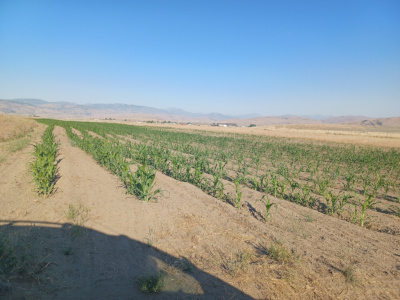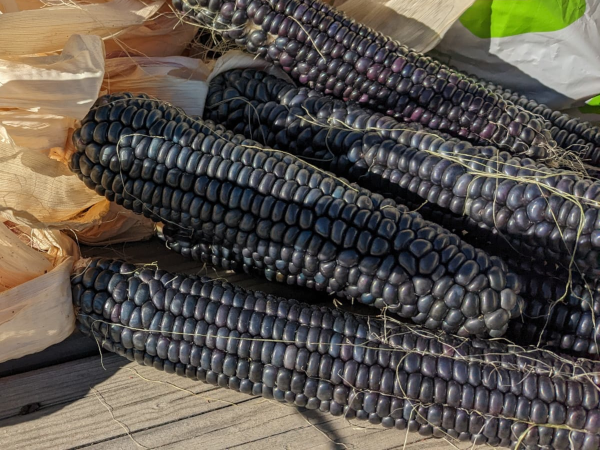Sustainable Production of Staple Crops in an Arid Environment Without Irrigation


As populations increase developing methods to improve soil, conserve water, and produce food sustainably under adverse conditions becomes increasingly important. In short I want to proove that a 20 acres without water for irrigation in north central Washington state can produce enough food for a family of 5 (2 adults and 3 childen). This will involve growing enough produce for human and livestock consumption supplemented by limited well water.
Of primary importance is the ability to produce sufficient quantities of carbohydrate rich foods that are easy grow, store, and process at home. Corn, potatoes, and sorghum are carbohydrate rich, easy to process, grow seasonally in cooler climates, and can be stored for use later use particularly during winter when crops can't be grown outdoors. Wheat, rice, millet, quinoa, amaranth, sunflowers, and cassava are either smaller, more difficult to process, or need a longer growing season. Sustenance farming requires sufficient arable land and good access to water and/or sufficient rainfall. In areas with low rainfall growing crops without irrigation is difficult but it is possible that some varieties of corn adapted to the American Southwest may produce under the right conditions. We focus on Hopi corn because it can be grown without irrigation, stores well, is high in carbohydrates, is easy to process, and can be used for both human and livestock consumption.
Our aim is to grow our own food and trade for things we don't grow while increasing the water holding capacity, fertility, and productivity of our soil. The plan includes planting of windbreaks, adding fertilizer, contouring or making swales to increase water infiltration, tilling as needed, and planting crops to capture rain & snow, reduce surface evaporation, and increase the nitrogen content & percentage of organic matter of the soil. Initially we apply an inorganic fertilizer followed by planting a legume crop in areas of the our property to produce a nitrogen rich mulch. As organic matter is produced, we will transition to using a minimal amount of inorganic fertilizer to maintain the legume crop, and use the perpetually generated a nitrogen rich legume mulch for staple crops like corn, wheat, and sorghum. The legume and staple crops will be used for human and livestock consumption producing fertilizer and improving overall soil health and fertility.
While turning uncultivated land into a sustainable homestead farm is not unique, our property is extra challenging since our well produces less than ½ a gallon per minute, the growing season is short, the topsoil is shallow and poor, and the environment is cold, dry, and windy. The major difficulty is simply the lack of water and all living things require water. An annual precipitation of less than 12 inches and a well that produces less than ½ a gallon per minute may not seem like much but using drip irrigation it is enough to run 600 ½ gallon per minute drippers (assuming 300 gallons are allocated for gardening). We use 3 drippers or 1½ gallons per day around 20 semi-dwarf fruit trees and grape vines and are able to keep them reasonably healthy and produce fruit (increasing drippers may be needed if the trees or vines get larger). To conserve water it is a good strategy is to plant a few seasonal vegetables around each fruit tree near the drippers. The bulk of crops produced have to survive on natural precipitation alone, eg dryland farming.


Hopi Blue Corn Ears / 2022
|


Hopi Blue Corn Shelled / 2022
|


Hopi Blue Corn Seeds / 2022
|


Hopi Blue Corn Flour / 2022
|
Soil quality (topsoil depth) and wind are additional issues. There was a fire on our 20 acres which burnt most of the sagebrush in 2016, there are no trees, and in most places there is 1-2 feet of silt covering glacial till covering sand, gravel, and rocks. The soil has few nutrients and the well water is pH 8.2. Annual rainfall is less than 12 inches with most precipitation being snow in winter months and almost no rainfall from mid June till mid September. Winter temperatures can get down to -13° F with 18mph winds, wind chill factor -32° F with snow usually 1-3 feet deep and drifts up to 10ft deep. Days with windspeed 12-25 mph are common and winds of 40mph with gusts up to 75mph occur several times a year. We have planted several species of pines (ponderosa, pinion, austrian) in a 500ft L shape as a wind break that will take many years go grow. Ponderosa pines are notably drought tolerant and once established should not need supplemental irrigation. Ponderosa pines should grow well here since many are visible growing at the same elevation and up the sides of nearby rocky bluffs. Pinion pines are also quite drought tolerant and should eventually yield pine nuts large enough to eat though they they do suffer some setbacks/damage by the cold winters. We also planted 20 or so elm trees which grow quickly and are drought tolerant and in 2024 an invasive Tree Of Heaven sprouted in the middle of the tilled and fertilized, but unirrigated, Concha White corn field.


We Discover Hopi Corn Can Grow & Produce Without Irrigation
After trying different drought tolerant crops for several years, in 2022, we tried Hopi Blue Corn and Ba Ye Qi sorghum in a 40×60 plot. After planting the Hopi Blue Corn we changed the garden layout, tilled deeply, and replanted part of the area with drip irrigation. Surprisingly some of the deeply tilled corn grew in an area without irrigation just as well as the irrigated corn and produced ears with kernels. Hopi Blue Corn is a soft flour corn that is easy to process and grind, and the raw kernels are easily chewed. Before cooking dry Hopi Blue Corn tastes starchy and very slightly sweet. If harvested at the milk stage Hopi Blue Corn can be cooked and eaten similar to sweet corn.
A Hopi farmer named Akhima, other Hopi farmers and researchers like Michael Kotutwa Johnson, and the journal article Collins, G. N. "A Drought-Resisting Adaptation in Seedlings of Hopi Maize." Journal of Agricultural Research Research, vol. 1, no 4, 2014, pp, 293-302 are good resources on how the Hopi plant and care for their corn fields. Collins tested 3 varieties of corn and found in contrast to the other 2 types he tested the Native American type could successfully grow when planted as deep as 12 inches. This article is worth reading and the pictures at the end are amazing. The plates show corn 3 ft tall with ears making up half the height! Adapted planting styles and local climatic conditions in the Southwest allow these types of corn to grow and produce in hot arid inhospitable climate of northern Arizona. Farmers rely on snowfall to provide water during the early stages of growth and summer monsoons supplement water during tasselling, pollination, and grain fill. Corn is planted in hills 7-20 seeds per hill and after emergence the weaker plants are thinned to 4-7 plants per hill. Farmers choose low areas to collect monsoon runoff and protect the crop of wind, and plant in areas adjacent to rabbit-brush which is an indicator of underground water. Some native types of corn can be planted up to 18" deep using soil moisture from snow and spring rains to germinate and the once established the roots grow to get water stored several feet, possibly up to 8 feet underground.
In the Southwest where Hopi Corn is traditionally grown summer monsoons provide several inches of rain. We have a shorter growing season and get little precipitation during the summer months, see our Weather Comparison Table. We tested various planting methods in 2023 and 2024 to see if we can get a reasonable yield under local conditions and found that fertilizer should be tilled in before planting and smaller plantings (up to an acre) can be managed using a drill with garden augur.
Optimizing plant density is key to improving both quality and yield. With a large area of unirrigated land available increasing yield per acre is less important than increasing yield per labor and inputs. In 2025 we will continue our expermients focusing on optimizing plant density and planting arrangement (planting singly vs hill method).
Drought Tolerant Hopi Corn Seeds
See Our New 2025 Corn Spacing & Yield Calculator
Dryland Hopi Corn 2025
Dryland Hopi Corn 2024
Dryland Hopi Corn Experiment 2023